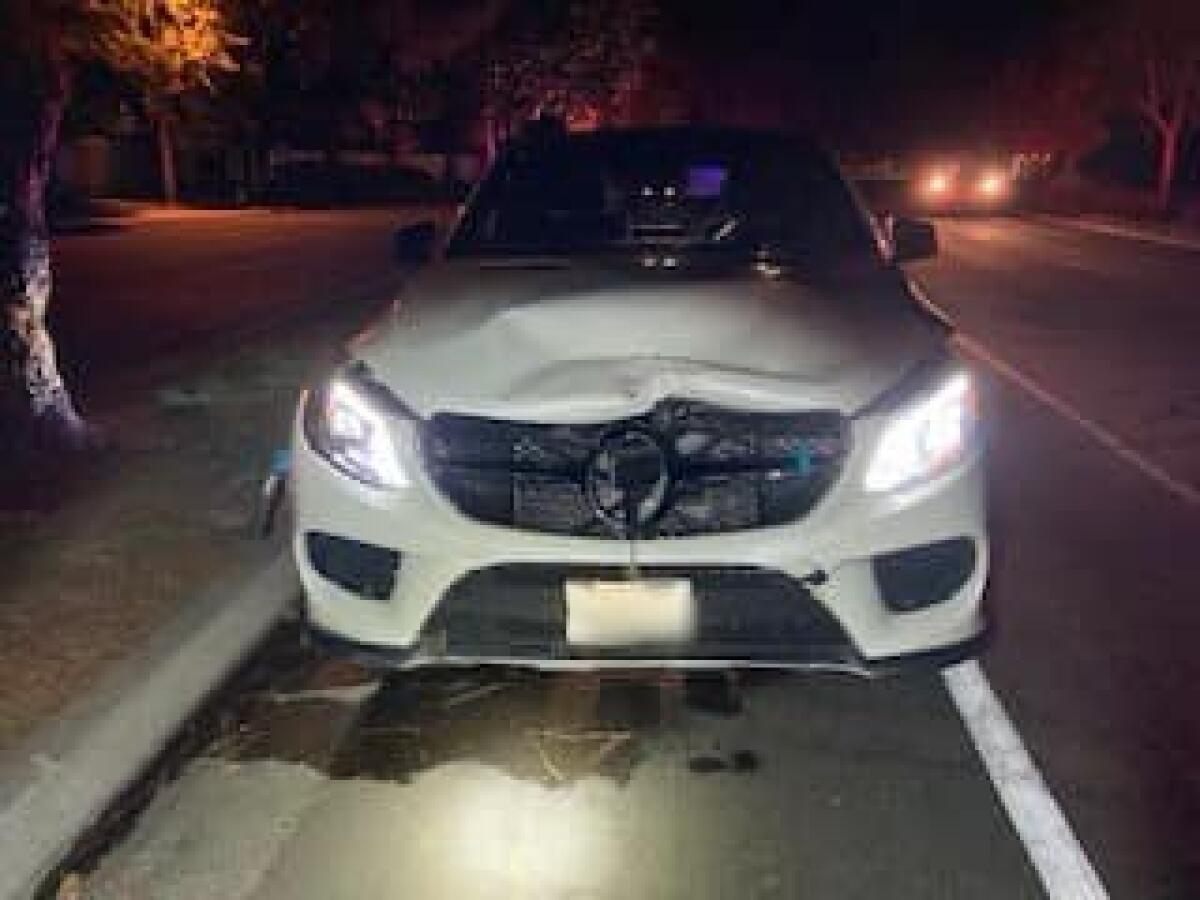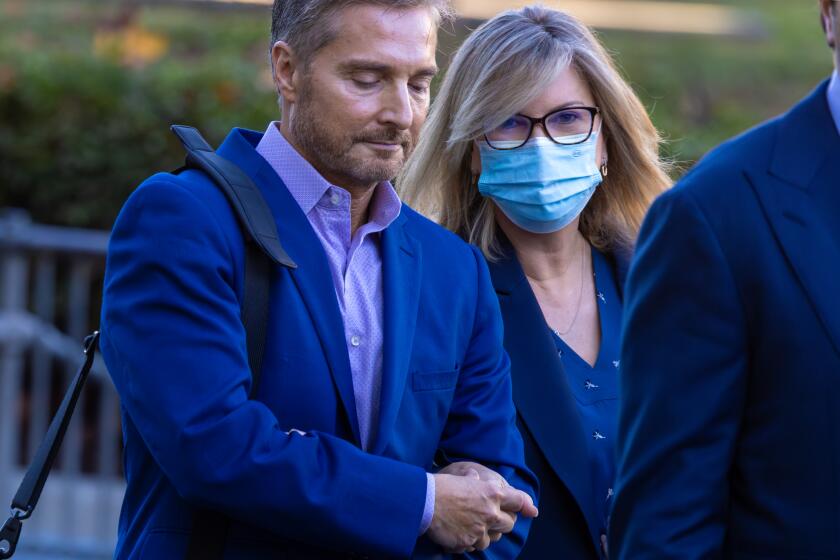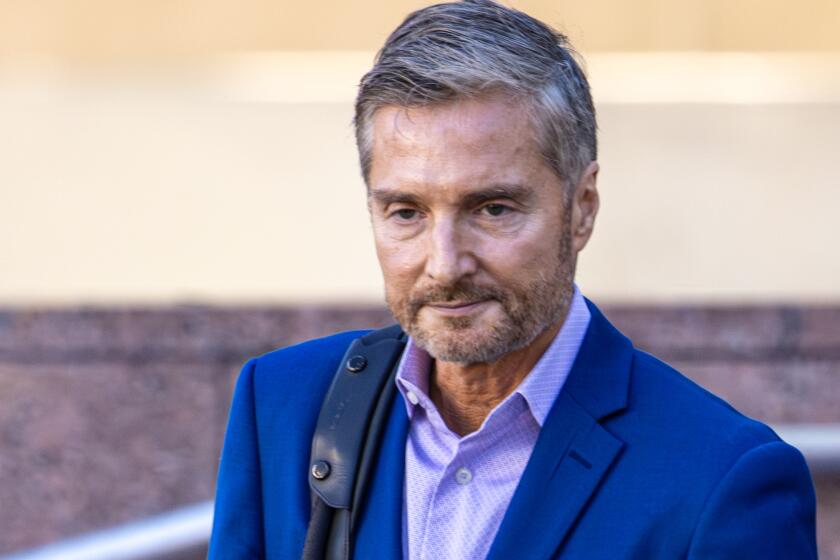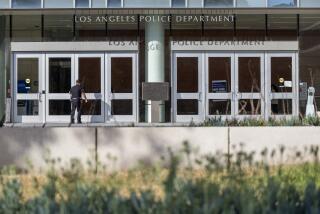Defense hammers at portrayal of Rebecca Grossman as reckless and impaired

- Share via
Rebecca Grossman is accused of speeding through a Westlake crosswalk and barely applying the brakes of her white Mercedes SUV before slamming into two young boys.
A former NASA scientist said Wednesday at her murder trial the Hidden Hills woman didn’t have time to slam on her brakes before her airbags deployed. Stephen Casner also testified for the defense that it was “hard to imagine” that the children were not first struck by a black Mercedes SUV that preceded Grossman through the crosswalk.
Grossman is accused of driving her Mercedes SUV at high speeds on a quiet Westlake Village street, closely following the Mercedes driven by her then-lover, former Dodgers pitcher Scott Erickson, with whom she’d earlier had cocktails.
Investigators testified she was going 73 mph when she fatally struck 11-year-old Mark Iskander and his 8-year-old brother, Jacob, having tapped the brakes a second and a half before the collision triggered her airbags.

Casner, a human factors expert who retired from NASA and author of the book “Careful,” about the psychology of safety, said studies show “it takes a lot longer than 1.5 seconds for most people to slam on the brakes.”
He downplayed previous testimony by an expert witness for the prosecution about the role of speed in the tragedy. He faulted the data that were cited and said the testimony “was probably irrelevant.”
Casner was among several witnesses brought in by defense lawyers as they sought to undercut the prosecution’s case against Grossman. She is charged with two counts of second-degree murder, two counts of vehicular manslaughter with gross negligence and one count of hit-and-run driving resulting in death in the fatal collision.
Tony Buzbee, Grossman’s lead attorney, has maintained from the outset of the trial that it was Erickson who struck the two boys, sending 11-year-old Mark vaulting into the path of his client’s vehicle.
The prosecution has rested and the defense will begin presenting its case this week in the murder trial of Rebecca Grossman, charged in the deaths of two young boys in a traffic collision in Westlake Village.
As he questioned Casner, Buzbee said there were four key witnesses to the tragedy — the boys’ mother, Nancy Iskander, who dived with her 5-year-old out of the path of Erickson’s black AMG Mercedes; Susan Manners, who stood 12 feet away on the roadside; and two people, Jake Sands and Yasamin Eftekhari, who witnessed the tragedy from a car.
Iskander testified she saw Erickson’s car go through the crosswalk and rescued her 5-year-old from its path before seeing her older boys vanish after Grossman’s vehicle went through. Manners said she heard one impact and then she saw Mark struck. Sands and Eftekhari described seeing Jacob hit. Those witnesses have differed over which lanes the impacts occurred in.
“Is it possible to come up with a coherent theory?” Buzbee asked Casner, who reviewed the witnesses’ testimony.
“I hear many different scenarios,” Casner replied.
Buzbee then arranged two court chairs to represent the black and white Mercedes SUVs. Portraying himself as Nancy Iskander, he approximated the location of the children.
“Is there any way the black car missed hitting the kids?” Buzbee asked.
“It is hard to imagine that car getting through and people just standing there,” Casner replied.
Prosecutor Jamie Castro noted, however, that in an April report that was what Casner said occurred. The former NASA scientist acknowledged that he wrote that Erickson’s vehicle passed through the crosswalk without hitting anyone before Grossman’s vehicle entered it.

Casner said that theory was based on what he knew at the time.
Under questioning by Castro, Casner also conceded that in his book “Careful,” he wrote that even a single alcoholic drink could have immediate effects on a person.
Following the fatal accident, Grossman tested at or slightly below California’s legal alcohol limit, but investigators and criminalists have testified that she was impaired by a combination of alcohol and Valium. Grossman’s defense team attacked that testimony.
A retired Houston detective sergeant, Donald Egdorf, testified for the defense, saying the field sobriety test done at the collision scene “was an example of what not to do,” offering a dissection of errors.
Egdorf, a drug and alcohol recognition expert, said he had done thousands of such investigations and that, based on the majority of evidence including the videos of her behavior, Grossman was “not intoxicated or impaired” after the collision.
Peter Grossman, the husband of Rebecca Grossman, testified Tuesday that he has ridden in the car with her hundreds of times and could not ever recall her speeding.
The witness also spoke to the overall investigation, saying it would be usual to document evidence at the crash scene with hundreds of photos and then carefully gather evidence for preservation. Jurors have already heard that items including two Mercedes emblems an investigator said were smashed off the front of Grossman’s Mercedes are missing and not in evidence.
Jurors also heard from a video expert, David Notowitz, who testified for the defense that — based on a video from a home security system — Grossman was going 52.7 mph after her Mercedes had traveled 202 feet from the crosswalk. That testimony appeared designed to undermine prosecution experts who have testified the Mercedes 43 GLE AMG was going 81 mph before Grossman braked slightly before impact.
Under cross-examination, Notowitz admitted he could not say how fast Grossman was going while in the crosswalk. Buzbee, however, questioned how his client’s car could slow so rapidly in such a short distance: “We don’t have a camera for that, but we do have is common sense.”
More to Read
Sign up for Essential California
The most important California stories and recommendations in your inbox every morning.
You may occasionally receive promotional content from the Los Angeles Times.













